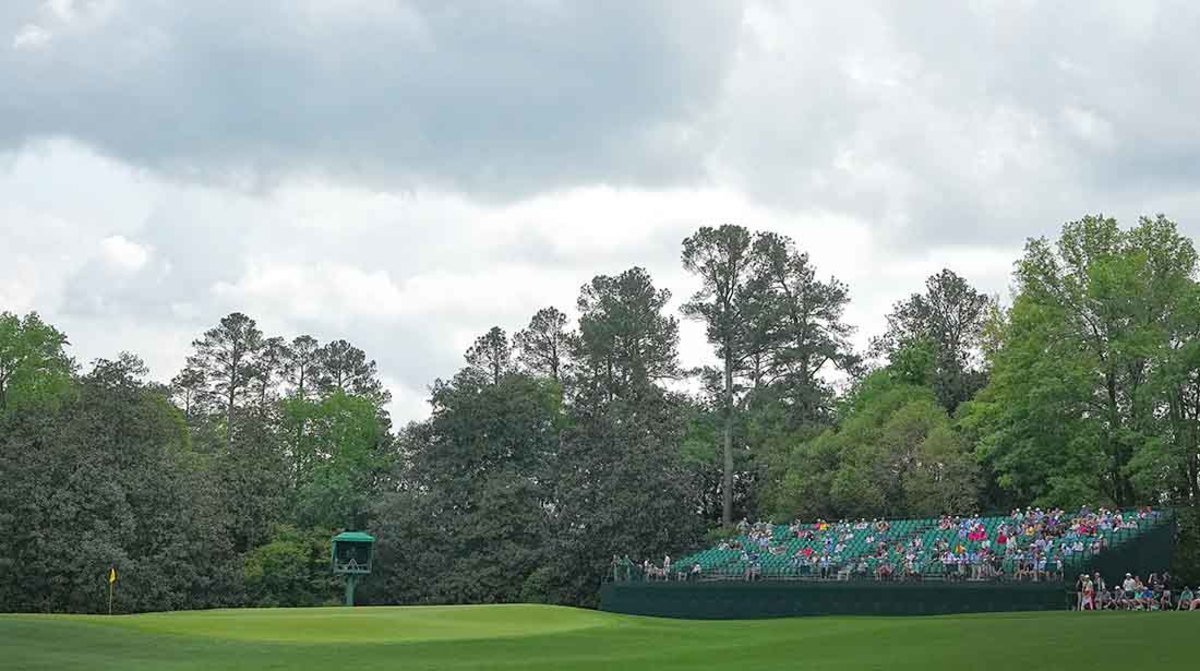Hole No. 5 Remains Augusta's Most Quiet Corner, Which Players Dread But Photographers Love

AUGUSTA, GA. — No one remembers why Augusta National’s par-4 fifth hole went into the Federal Witness Protection Program. Under the alias “Magnolia,” the hilltop dogleg made a brief appearance at the 1995 Masters, when 55-year-old Jack Nicklaus holed out for eagle twice in three days. (Unfortunately, neither miracle shot was televised.) Arguably the National’s most difficult hole, No. 5 is paradoxically its most unseen. Patrons making the trek to the course’s most-distant corner, having heard that Magnolia lacks spectator appeal, rarely climb the hill. Fewer still inhabit the grandstand to the right of the fifth green, where pros make birdie about as often as Patrick Reed cops a plea.
“It’s the hardest hole out here,” Max Homa opined after his first-round 71. He smiled vacantly, however, when asked if No. 5’s new tee and other design alterations had changed the way he plays the hole. “Guess I didn’t notice,” he said, suggesting that some players play the fifth the way some witnesses take the Fifth—defiantly, but with the knowledge that the slightest slip can lead to hard time.
Magnolia’s primary claim to non-fame is that it is the ANGC hole least likely to appear on the cover of a magazine or a coffee-table book. It was startling, therefore, to encounter legendary golf photographer David Cannon to the right of the fifth fairway on Friday morning. Wearing a bucket hat and a bulky accessories belt, Cannon had one camera slung over his left shoulder and another, the one with the big telephoto lens, on a monopod.
“You’re right, no one comes out here,” Cannon said. “But I’ve been here practically all day, every Thursday, for the past ten years.”
Say what? From the shade of some pines, sixty yards beyond the landing area for most tee shots, Cannon had a good view of…nothing. The white-sand fairway bunkers, facing the tee, were invisible. The opposite side of the fairway, where hooked drives bounce downhill and out of view, was equally unphotogenic: a featureless wall of trees. That, Cannon quickly made clear, was the point. “The light is great, and those trees are a perfect photographer’s backdrop. We call this hole ‘the studio.’”
And not just the fairway. “Up behind the green is great, too,” he said. “Look at this.” He rotated the back of his camera to display a dramatic image of former Masters champ Mike Weir hitting out of the bunker behind the green. Magically illuminated in the center of the frame, Weir appeared to be wrapped in black. “That’s reflected light from the white sand,” Cannon explained. “It lights up their faces.” Among his favorite Masters shots are snaps of Phil Mickelson and Tiger Woods escaping the Magnolia bunker, Phil wearing black, Tiger in his Sunday red. “It’s a great hole,” Cannon summed up. “It makes pictures I like.”
Tour players, it should surprise no one, tend to be more guarded about No. 5. “It’s one of the hardest holes on the course,” Joaquin Niemann said on Thursday, finding little else to say. “I don’t know what the changes were,” said defending champion Scottie Scheffler. “It just seems really hard to me.”
It didn’t used to be. A decade ago, Magnolia ranked anywhere from fifth- to 11th-hardest at Augusta National, surrendering 30 to 40 birdies per Masters. Looking to restore its 1933 shot values, the National pushed the big bunkers further into the fairway, narrowed the driving corridor and sent scores on an upward spiral. From 2019 to 2022, No. 5 was the tournament’s toughest hole three times. In 2021, it gave up only seven birdies and played to a stroke average of 4.430—“insanely hard” in the words of tour player Ben Crane; way too hard for a hole Masters patrons can’t pick out of a police lineup.
For this year’s Masters, the National built a new tee (on land snatched from a rerouted Berckmans Road), widened the fairway and introduced the “new” par-4 of 490 yards. Chairman Fred Ridley’s goal of “protecting the shot values Mr. Jones and Alister McKenzie devised,” if realized, would be reflected in fewer pars, more birdies and bogeys, and—dare to dream!—more screen time.
Nice try, Fred. Round One of the 2023 Masters saw only two fifth-hole birdies, one by Scott Stallings and another by Tony Finau, who admitted that his approach shot to the devilish green, landing a foot shorter, would have rolled 60 feet back down into the fairway. As for changes in strategy, the long-hitting Finau shrugged. “I still hit driver. Then hit a nice little 5-iron.” Corey Conners seemed to be on the same page, saying, “I’ve got a game plan there. Just swing as hard as I can with driver and then hit it in the middle of the green.”
Those vaunted shot values? “It’s definitely a better hole coming into it with a 7-iron,” said former PGA champ Jason Day. “It’s not a 4-iron green.” Sound analysis, for sure, but he failed to specify who was forced to smoke the 4-iron. Or what year he was talking about.
When play was suspended late Friday afternoon, Magnolia ranked number one in scoring difficulty, ahead of the par-4 11th, with three birdies, 113 pars, 50 bogeys, 5 double bogeys, one “other” and a swollen scoring average of 4.349—a bit higher than 2022’s fifth-hole average of 4.332. Plus ça change and all that.
So yeah, Magnolia is still Augusta National’s most quiet corner, a hole where drama is rare and photographers indulge their portrait-studio fantasies. The point was made on Friday morning when Irish amateur Matthew McLean had to back off his tee shot twice—seemingly bothered by a young couple whispering endearments in the trees, sixty yards away—before smothering a hook into the fifth-hole bottoms. Leaving the tee, McLean exchanged words with a bemused tournament marshal before walking off.
Was it the couple’s chatter, we asked the marshal, that had distracted McLean?
“No,” he said. “It was a butterfly.”

